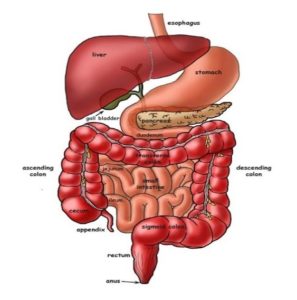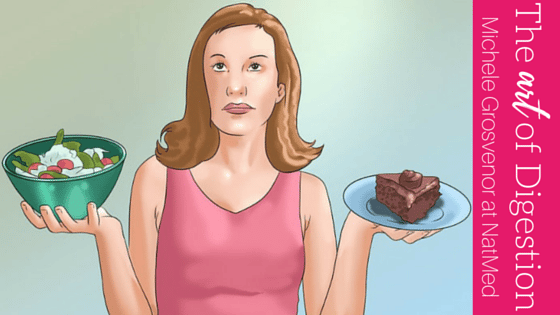THE ART OF DIGESTION
Digestion. . . Have you ever wondered how the nutrients from your food make it into your cells?
Or how last night’s dinner became today’s source of essential amino acids, vitamins, minerals and essential fatty acids?
. . .To understand how the body gains access to these nutrients we need to take a look at the complex process of digestion.
What is the Digestive tract?
The digestive, or gastrointestinal, tract is essentially a long hollow tube that begins at the mouth and ends at the anus.
The specific parts that make up this tract are the mouth, esophagus, stomach, small intestines, large intestines and the anus. Other organs involved that lie outside the gastrointestinal tract: termed the accessory organs, are the pancreas, gallbladder and the liver.

. . . When we consume food a series of mechanical and chemical processes occur that turn our protein, carbohydrates, and fats into nutrients the body can readily absorb.
Did you know that digestion begins in the brain?
Just thinking about, or smelling food, stimulates a reflex in the brain that triggers-
1. the secretion of saliva in the mouth and 2. hydrochloric acid in the stomach.
Once food is put into the mouth the process of mechanical digestion begins, through the action of chewing.
The purpose of this is to increase the surface area of your food molecules to allow salivary enzymes such as amylase, to begin breaking down simple sugars which can be quickly absorbed.
This is why when you eat something like potato you can taste it getting sweeter after a few chews.
What happens next?
From here the mix is moved through to the esophagus, which simply connects the mouth to the stomach.
The stomach acts as a holding area releasing small amounts of food into the small intestines. It is a highly muscularized organ that acts like a mixing bowl, churning your food and liquefying it into something called chyme.
The hydrochloric acid found here converts the enzyme pepsin into its active form – which splits apart simple proteins.
This can take time and is what makes you feel full when you eat a meal containing good quality protein.
Fat digestion also begins here, but to a much lesser extent.
Where do most of my nutrients get absorbed?
Your nutrients are absorbed predominantly in the small intestine, which is lined with fingerlike villi to increase the surface area available for nutrient absorption.
What about the rest? . . .
- The pancreas – is responsible for alkalizing the stomach contents moving down, it does so with the help of the secretion of approximately 1-1.5 litres of pancreatic juices (produced daily).
- Carbohydrate digestion resumes when pancreatic enzymes are secreted, they convert complex sugars into simpler forms (which can be directly absorbed by the gut wall).
- Protein digestion is finalized through specific enzymes which split them into their smallest building block components – amino acids.
- Most amino acids cannot be simply absorbed through the gut wall like carbohydrates, and require special transportation structures to carry them across.
- Others are sent to the liver to be assembled into protein sequences that are used for maintenance and repair.
- When fat first leaves the stomach it is too large a size to be readily absorbed. Bile secreted from the gallbladder acts like a detergent on these molecules – breaking them down into more manageable sizes.
- Specialist fat enzymes then further break them down until they can move through the gut lining and bind to carrier proteins to become something called a chylomicron.
- These chylomicrons are often able to be observed when looking at your blood under the microscope – they are the structures that look a bit like mini mosquitoes buzzing around.
The end product…
Finally, the more fibrous carbohydrates that can’t be broken down further travel down to the large intestines.
Here resides our largest ecosystem of our gut flora which help ferment these into certain types of fatty acids such as butyric acid. Butyric acid has been suggested to have beneficial effects on reducing intestinal permeability and maintaining gut barrier integrity.
Eventually when everything has been broken down into its smallest components and rendered indigestible, with the remaining water absorbed, a stool will be produced. Taking note of what your stool looks like can tell a lot about your digestion and a question often asked by a Naturopathic!
So what next?
As a Naturopath with an interest in digestive health I often talk to my clients about simple things they can do on a daily basis to optimize their digestion and gain the most nutrition from their food. Here are a few simple things you can incorporate into your daily routine:
- Take time to sit down – to eat and be present.
- Think about the environment you are eating in – it is stressful or tense? Are you eating at your desk and multitasking? Having a heated discussion over dinner or feeling rushed? These situations and feelings contribute to your nervous system’s response. When your body is sensing stress, more technically termed the “fight or flight” response, it shunts the blood away from the digestive tract to other areas of the body. This shuts down your digestive processes and impairs function.
- Prepare your digestive system for food – consuming fermented foods, bitter greens, lemon juice and/or apple cider vinegar before your meals all can help to stimulate digestive secretions such as HCL production in the stomach
- Digestion begins with chewing – concentrate on chewing your food properly. Gulping or inhaling your food makes digestion harder work down the line.
- Put your knife and fork down between mouthfuls to slow down the pace and allow your digestion to catch up.
- Avoid drinking with your meals unless you are consuming something like bone broth. It dilutes the digestive enzymes required for breaking up your food.
- Listen to your body – by eating slower, you will notice when you feel full. This is the time to put your meal to the side and stop eating.
If you suffer from digestive issues and would like more help resolving them – please contact me,
Michele Grosvenor, for a free 10-minute chat to explore how I could help you.
☏ 9339 1999
Michele Grosvenor is a certified GAPS(TM) practitioner. If you have any questions about GAPS(TM), find out more here

